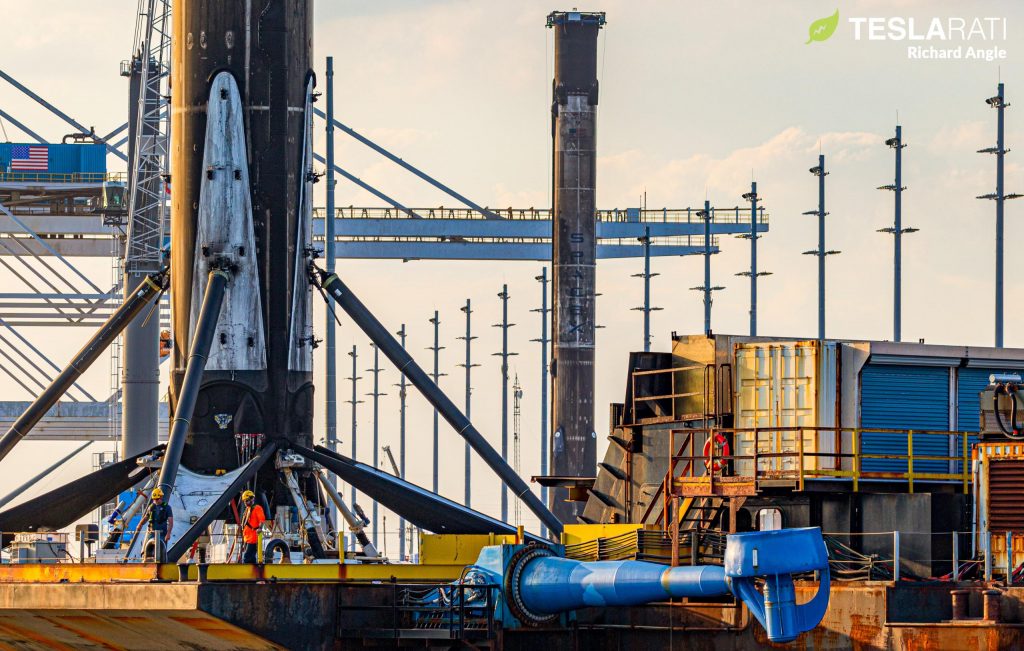For the first time, two SpaceX Falcon 9 boosters – fresh from two successful Starlink launches and landings – met at Port Canaveral, creating the first ‘bottling’ rocket of its kind.
On March 11, the Falcon 9 B1058 booster reached its sixth launch and landing after supporting SpaceX’s sixth dedicated Starlink launch (Starlink-20) this year. 74 hours later, a separate Falcon 9 rocket took off from SpaceX’s second East Coast launch pad, successfully sending another batch of 60 Starlink satellites (Starlink-21) on their way into orbit. For its role in the mission, the B1051 booster became the first Falcon stage to launch and land nine times – just shy of a ten-flight rocket reuse goal that SpaceX has been pursuing for years.
Now, in addition to setting the new standard for Falcon reuse, placing 120 satellites in orbit in three days and breaking the SpaceX record for the shortest turnaround between two East Coast launches, Starlink’s consecutive launches have left both Falcon boosters 9 in the right place and the right time to cross paths while preparing for future flights.


As SpaceX began to increase its orbital launch cadence – largely thanks to Starlink – throughout 2020, it became clear that the company would eventually begin to find new pressure points as it took its fleet of reusable rockets and its recovery assets to new limits. In 2021, this intentional stress effort across SpaceX’s broader launch pipeline became even clearer.
In just 10 weeks in 2021, SpaceX has completed eight orbital launches, averaging one mission every nine days or 40 launches a year if extrapolated by the end of 2021. Just two days before the Falcon 9 B1058 booster arrives back to Port Canaveral after its successful launch of the Starlink-20, the Falcon 9 B1049 booster – the last task of the launch of the Starlink-17 on March 4 – completed the port’s processing and was transported by road back to the Cape Canaveral Air Force (CCAFS) or Kennedy Space Center (KSC) to get ready for its ninth flight.
At that point, it was clear that it was only a matter of time before two boosters simultaneously occupied SpaceX’s Port Canaveral cradles. Two days later, the record-breaking Falcon 9 B1051 booster arrived back in port and was received by the B1058 booster – legs retracted, standing upright and waiting to be ‘broken’ (placed horizontally) for transport.
It is hard to imagine a better, or (excuse the buzzword), more synergistic boosters to appear in port together. In its separate launch debuts, the Falcon 9 B1051 supported the spectacularly flawless launch of the Crew Dragon, while the Falcon 9 B1058 became the first private rocket in history to launch U.S. astronauts 14 months later. Known as Demo-1 and Demo-2, these two missions collectively mark the most significant milestone in the history of modern US space flight, ending a decade-long period when the United States was unable to launch its own astronauts.


Just a week after the launch of the Rocket Demo-1 in 2019, the Falcon 9 B1051 is the new ‘leader of life’ fleet booster (the most flown rocket) after an average of one launch every 11 weeks for the past two years. In addition to supporting the launch of Cargo Dragon 2 last December, the Falcon 9 B1058 flew six times, with an even more impressive launch average every eight weeks. Together, the two boosters reached 15 orbital-class launches about 190 metric tons of Dragon satellites and spacecraft in orbit in their two-year career, significantly more than the maximum payload of Saturn V – the largest rocket successfully launched.
The Falcon 9 B1051 could fly for the tenth time as early as April 2021.





